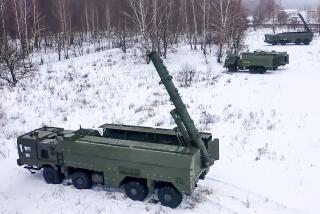Does Moscow Know Where Its Nukes Are? : Soviets: The safeguards on their weaponry never envisioned an era of internal chaos.
- Share via
Senior U.S. policy-makers must prepare for the real possibility that the first Soviet nuclear weapon fired in anger may be directed not at the United States but at internal enemies. Some may consider this consoling after the dark days of the Cold War when fears of a coordinated nuclear surprise attack from the Soviet Union dominated U.S. military planning. However, the new environment offers little true comfort and indicates the need for a careful review of U.S. policy.
The Soviet Union may soon enjoy the dubious distinction of being the first nuclear-armed empire to dissolve. The resignation this week of Foreign Minister Eduard Shevardnadze underscores just how fragile is the Soviet hold on stability. As central authority continues to erode, Western analysts are concerned about a particularly alarming side-effect: an unauthorized use of nuclear weapons.
To date, the Soviet command-and-control system has ensured the security of nuclear forces, but policy-makers must not be sanguine about the future. The Soviet command system was designed to meet a very different array of threats from the ones confronting it now.
The system was designed to ensure two goals: that the command authority would survive a U.S. preemptive attack, and that lower-level military officers could not use nuclear weapons without explicit direction from central authorities.
A complex mix of procedures and physical measures ensure the success of both endeavors. Nuclear stockpiles and command sites are hardened and dispersed to enhance their survivability. The Soviets rely on parallel chains of command, with both the regular military and the KGB sharing control over nuclear weapons. For part of the arsenal, warheads are held by KGB troops and kept separate from the delivery systems. Other parts of the arsenal are protected by built-in coded locks, similar to the Permissive Action Links (PALs) deployed on U.S. weapons.
Will these measures be adequate when the principal threats come from within the Soviet Union? Consider two scenarios: military coup and ethnic revolt.
Control over nuclear weapons might play a central role in any coup attempt by Soviet military leaders disgruntled with Mikhail Gorbachev’s reforms and growing anarchy in the Soviet Union. The rebellious officers may be sufficiently powerful to overrun local KGB positions and seize nuclear weapons. PALs would offer no protection if the coup were led by very senior KGB and military commanders who presumably hold the codes needed to unlock the weapons.
Local radical groups seeking the ouster of central authorities may attempt to steal nuclear weapons from the dispersed stockpiles. Coded locks offer little protection if mere possession of the weapon may be enough to make blackmail effective. Even if the locks prevented a nuclear explosion, the blackmailers could threaten to blow up the weapon with conventional explosives and spread radiological contamination.
These threats would severely challenge an advanced and capable command-and-control system. If the Soviet system is not as good as we are led to believe, then the situation is even worse.
For instance, Soviet officials reassure us that their nuclear weapons are protected by advanced PALs. However, only the most modern weapons are likely to have these devices. The Soviets have been reluctant to destroy obsolete weapons, preferring to stockpile older weapons. Sizable stockpiles of nuclear weapons equipped with only the most rudimentary safety and security features may be scattered throughout the Soviet Union--some in ethnically troubled regions.
Evidence suggests that the Soviet leadership is itself worried about the security of the nuclear arsenal and has moved weapons out of areas of ethnic unrest.
Such a move may buy the leadership some time but it will not be sufficient if the overall command-and-control system unravels. If ethnic and regional challenges to central authority spread, there may be no safe place in the Soviet Union for its sizable nuclear arsenal. The only solution may be to rewire the system from the ground up.
The implications for U.S. policy are clear. Senior U.S. policy-makers should engage their Soviet counterparts, however discreetly, in a thorough dialogue. Direct and frank military exchanges offer the possibility of establishing “rules of the road” to govern American responses to a nuclear crisis within the Soviet command structure. U.S. military planners should conduct a thorough review of the implications for our policy of such a collapse of Soviet command and control. At a minimum, we should scrutinize our own command system, especially the elements associated with early warning and attack assessment, in light of the risks posed by huge stockpiles of nuclear weapons in a disintegrating Soviet empire.
More to Read
Sign up for Essential California
The most important California stories and recommendations in your inbox every morning.
You may occasionally receive promotional content from the Los Angeles Times.













